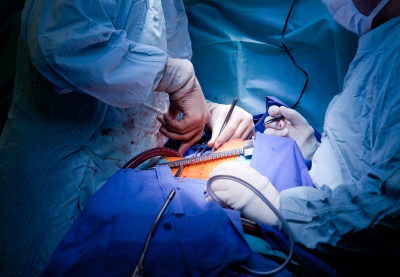Clinicians at Cambridge University Hospitals have become the first in the UK to treat a bleed on the brain – via the wrist.
They inserted a steerable catheter into the trans-radial artery before using normal interventions, such as a mesh stent, surgical coil and glue, to close off the aneurysm.
Radiologists say the technique, an alternative to accessing the femoral artery via the groin, was such as success it paves the way for similar procedures in the future.
The patient who had the procedure, Stuart Johnson, 55, a director of a consultancy business with offices in London and East Anglia, has worked on projects relevant to both Addenbrooke’s and his aneurysm experience.
He was project manager on the building of the Simon Sainsbury Centre at the University of Cambridge Judge Business School on the Old Addenbrooke’s site. The £32 million centre, built on the site of the old nurses’ hostels, opened earlier this month.
As project sponsor, he was responsible for construction of the Sainsbury Wellcome Centre (SWC) for Neural Circuits and Behaviour at UCL, a gift from David Sainsbury’s charity and the Well come Trust. SWC is a newly formed centre researching functioning of the brain and nervous system.
“I didn’t realize the procedure was a UK first until a few weeks ago,” he said.
“What I do realize, having read the outcomes of people with aneurysms like I had, is how incredibly lucky I was to be back at work five weeks after the procedure and not to have suffered any long-time side effects.
“For that, I am very grateful to the NHS and the clinicians at Addenbrooke’s.”
The technique means there is less chance of the artery or adjacent body parts being damaged and afterwards patients can move about freely, rather than have to lay on a bed for four hours. It’s expected they will be discharged earlier, which is good news for patients and the hospital.
Consultant interventional neuroradiologist Dr Yogish Joshi said: “The decision to  use the radial artery rather the femoral artery was for medical reasons – in this case the femoral artery had some damage that made it an unviable catheter route.
use the radial artery rather the femoral artery was for medical reasons – in this case the femoral artery had some damage that made it an unviable catheter route.
“However, the success of the procedure and its clear benefits, now opens up the more widespread use of this surgical intervention technique, which will greatly benefit patients.
Dr.Yogish Joshi
“Most procedures require access to the anterior [front] circulation, which is not so accessible from the radial artery. This case was a posterior [back of the brain] circulation aneurysm, and we were exploring the option of radial access same time as we were presented with the case. So it was fortuitous, I guess.
“It was only after we performed the intervention that we were told it was the first in the UK. The technique is widely used in Canada and in this country for interventions on other parts of the body, such as the heart.”
Dr.Yogish Joshi is from Newbury Park, London Borough of Redbridge- Editor

,
Readers like you, make ESHADOOT work possible. We need your support to deliver quality and positive news about India and Indian diaspora - and to keep it open for everyone. Your support is essential to continue our efforts. Every contribution, however big or small, is so valuable for our future.












Well doe, dear Yogesh.
we are all proud of you.
Great Job.